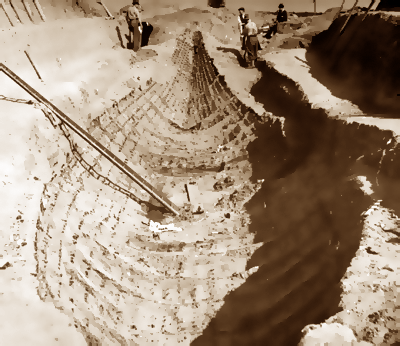|

|
|

How do we know it
was there at all?
 Before
Victorian times, ships were always made of wood. Wood rots when it is
put in the ground. So how do we know about the Sutton Hoo ship? Before
Victorian times, ships were always made of wood. Wood rots when it is
put in the ground. So how do we know about the Sutton Hoo ship?- The type of sand in the soil at Sutton
Hoo is very unusual. When things rot in it, they can leave their shape
in the soil.
- It looks like a dark stain. This can be
excavated if you are very careful. This was what happened in 1939.
- Look at the picture. The photographer is
standing at one end of the ship, looking towards the other end. You can
easily see the planks which the ship was made of.
- You can also see lines of dots in the
picture. These are the iron rivets which held the planks together.
- The ship was 90ft long.
- The archaeologists could also see patches
on the ship's hull. So the ship was not new when it was buried. It had
been to sea and had been repaired.
- It does not seem to have had a mast or a
sail. It was rowed by men with oars. There were probably 28 of them.
- It had a big triangular wooden chamber in
the centre - like half a tube of toblerone. This was where the dead
person's possessions were found.
- The ship had probably been dragged to
Sutton Hoo, on rolling logs, from the nearby River Deben.
- Another ship burial had been discovered
at Snape, only 9 miles away, in 1862. Viking ship burials have been
found in Norway too; and there were other ship burials in the mounds
at Sutton Hoo.
- The 'Beowulf'
poem tells of a ship funeral.
The ship was not buried, but sent out to sea.
- Activity
Sheets Available
|

